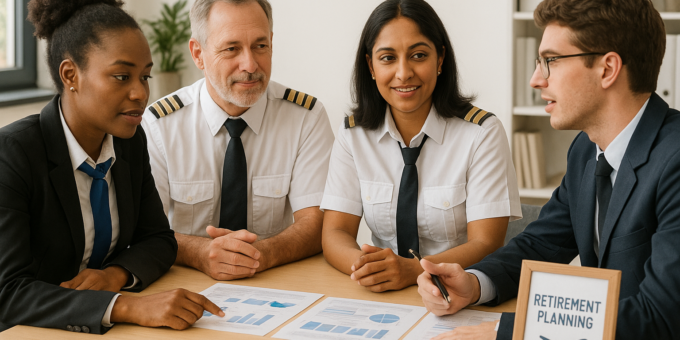
For pilots, flight attendants, air traffic controllers, and aviation engineers, the sky is not only a workplace—it’s a lifestyle. But just like every flight has a destination, every aviation career must also prepare for its final approach: retirement. And unlike many other professions, retirement planning for aviation professionals comes with turbulence—mandatory retirement ages, inconsistent pay schedules, demanding travel, and high-stakes health considerations.
While flying may give you the world, financial freedom requires you to ground your future in strong retirement planning. Whether you’re cruising at mid-career or preparing for landing in your final years on the job, this guide will navigate every altitude of retirement preparation—without any autopilot.
The Sky Isn’t the Limit: Why Aviation Professionals Must Prioritize Retirement Planning
Retirement planning isn’t just about stashing cash. It’s about securing peace of mind. Aviation professionals often deal with accelerated burnout, frequent relocations, and industry instability. The FAA mandates a retirement age of 65 for commercial pilots. Meanwhile, lifestyle inflation and luxury temptations (think first-class hotels, international shopping, and high-calorie layovers) can sabotage long-term financial goals.
Moreover, unlike 9-to-5 desk jobs, aviation doesn’t promise a straight financial trajectory. Some months are sky-high, others may be grounded due to airline restructures, furloughs, or even pandemics. In this context, being proactive isn’t optional—it’s critical.
Understanding the Unique Financial Challenges in Aviation
Pilots often start earning later due to extensive training, and when they finally reach a lucrative phase, it may only last a couple of decades. Many in aviation delay major life milestones like marriage or home ownership due to erratic schedules and locations. Additionally, global contracts, tax complexities, and fluctuating fuel and airline policies affect long-term income planning.
On top of all this, maintaining your medical certificate is essential to remain in the cockpit. One failed health check can end a career prematurely—making insurance and a contingency fund as vital as a co-pilot.
Why Pilots, Flight Attendants, and Engineers Need a Custom Strategy
Each aviation role brings different planning challenges:
-
Pilots deal with high income but short earning spans.
-
Flight attendants may have modest earnings but flexible side gig opportunities.
-
Air traffic controllers retire early but with structured pensions.
-
Aviation mechanics and engineers may have more stable ground-based careers but with slower growth.
That’s why cookie-cutter financial advice won’t fly here. A tailored approach—specific to your role, location, and long-term goals—is mission-critical.
Commercial Airline vs. Private Jet: How Career Paths Affect Retirement
Commercial pilots may benefit from union-backed pension plans and clearer retirement timelines. Private jet captains, however, might have more earning power but less financial structure. Freelancers and contract pilots also face volatile job security.
This career diversity means no single “aviation retirement plan” fits all. Those in corporate aviation should prioritize independent investment vehicles, while airline-employed individuals must optimize existing benefits before thinking outside the 401(k).
Age Limits and Forced Retirement Policies in Aviation
In many countries, pilots must retire by 65, regardless of health or passion. Air traffic controllers often exit even earlier—around age 56 in the U.S.—due to job intensity. If you’re not prepared for a career halt in your early 60s, you might face a rocky descent.
Planning for an earlier retirement age isn’t just wise—it’s mandatory. It means boosting savings aggressively in your 40s and 50s, and considering bridge employment strategies for the years before Social Security or pension eligibility.
Navigating Turbulence: Managing Irregular Income and Per Diem Pay
Many pilots and cabin crew receive a mix of salary, hourly flight pay, and per diem allowances. These can vary month to month, making consistent saving tough. The solution? Base your budget on your lowest average income. Treat any surplus as bonus income that goes directly into retirement, emergency savings, or debt payoff.
Apps like You Need a Budget or Mint help visualize fluctuating income and automate financial discipline.
Setting Clear Retirement Goals for Aviation Professionals
Ask yourself:
-
When do I want to retire—and where?
-
Will I downsize, relocate, or travel full-time?
-
What lifestyle do I envision—modest or luxurious?
-
Do I expect a second career post-retirement?
Your answers guide your target savings number. Use the 4% rule to estimate how much you’ll need: multiply your desired annual retirement income by 25. For instance, $80,000 per year means a $2 million nest egg.
Budgeting With a High-Flying Lifestyle
Aviation tempts extravagance—especially when you’re hopping from Dubai to Paris to Tokyo. But those hotel stays, airport meals, and spontaneous purchases can add up fast. Establish “travel budgets” per month, even when your trips are technically for work. Use travel cards with rewards and monitor expenses weekly.
Pro tip: Avoid lifestyle inflation. Just because your pay increased doesn’t mean your spending should.
Emergency Funds: Your Safety Net at 30,000 Feet
A grounded plane might be inconvenient. A grounded paycheck can be catastrophic. Aviation professionals should aim for 6–12 months of expenses in a high-yield savings account. Include your mortgage, insurance, and fixed costs.
Remember: your career’s volatility demands a higher cushion than traditional jobs.
Investing 101 for Pilots and Aviation Workers
Stock market investments offer the growth needed to combat inflation and fund a multi-decade retirement. Aviation pros often lean conservative due to job risk, but that’s a mistake. A diversified portfolio balances growth and safety.
Start with:
-
A Roth or Traditional IRA
-
Maxed 401(k) or employer plan
-
Broad index funds (like S&P 500 ETFs)
-
Sector investments in aviation, tech, or healthcare
IRAs, 401(k)s, and Aviation-Specific Pension Plans
Many airlines offer 401(k) plans with matching contributions—this is free money, so max it out! Others may provide pensions or profit-sharing. Learn your plan inside and out, and contribute the maximum annually if possible.
For self-employed pilots, Solo 401(k)s or SEP IRAs are excellent choices.
Diversification Strategies for Industry Uncertainty
Relying on one income source is risky. Diversify across:
-
Real estate (REITs or rentals)
-
Dividend-paying stocks
-
Low-cost index funds
-
Aviation side businesses (flight training, consulting, YouTube content)
This way, if your flying career hits turbulence, your finances don’t nosedive.
Investing in Real Estate While Flying Full-Time
Buying rental property? Consider management apps or a property manager—especially if you fly long haul. Real estate provides passive income and potential tax benefits. However, avoid overleveraging. Don’t assume constant rental income; build cash reserves to cover gaps.
Best Saving Practices for High-Earning Aviators
When income spikes, stash aggressively. Follow the 50/30/20 rule:
-
50% Needs (housing, transport, food)
-
30% Wants (luxury, travel, lifestyle)
-
20% Savings (retirement, investments, debt reduction)
Adjust these percentages to reflect flight bonuses or slow seasons.
When and How to Transition from Cockpit to Couch
Most aviation pros don’t go from flying to full-stop. Plan a gradual descent:
-
Fly part-time
-
Teach in flight schools
-
Do aviation consulting
-
Join safety boards or airline compliance teams
Planning a Second Career or Consulting Gig Post-Retirement
Love aviation too much to fully retire? Become a mentor, coach, speaker, or safety advisor. These roles allow flexible income and purpose without full-time pressure.
Downsizing and Geographic Arbitrage in Retirement
Consider relocating to low-cost countries like Portugal, Thailand, or Mexico. Your dollar stretches further, and aviation retirees often qualify for special expat visa programs.
Real Stories: How 5 Pilots Secured Their Retirement
We’ll dive into five case studies—one bought real estate early, one flew charters post-retirement, another built a drone company, one went full FIRE (Financial Independence, Retire Early), and another teaches aviation finance online.
Each took a unique path—but all started planning early.
Must-Have Apps and Tools for Financial Flight Planning
-
Personal Capital: Track net worth
-
YNAB: Budgeting for variable income
-
Fidelity / Vanguard: Low-cost investing
-
Pilot Finance Tools: Specialized calculators for retirement goals
Working With a Financial Advisor Who Understands Aviation
Not every planner gets per diem, deadhead flights, or fluctuating rosters. Work with an advisor experienced in aviation financial planning. Ask about flat-fee vs. commission-based structures.
FAQs on Retirement Planning for Aviation Professionals
How much should pilots save annually for retirement?
Aim to save 15–20% of your gross income annually.
What’s the best retirement account for a self-employed pilot?
Solo 401(k) or SEP IRA offers high contribution limits and flexibility.
Can flight attendants retire early?
Yes, but they must plan healthcare coverage and supplement lower pensions with savings.
Is loss-of-license insurance really necessary?
Absolutely—it’s your career parachute.
When should I hire a financial advisor?
By age 35 or once your income stabilizes above $80K/year.
What happens if I can’t fly anymore due to health issues?
Disability insurance and proper investment planning can replace income.
You Can Also Read : Best Retirement Investment Options for Pilots and Flight Attendants in High-End Airlines
Taking Control of Your Financial Future
Retirement planning for aviation professionals is more than spreadsheets—it’s your life’s flight plan. Each dollar saved is fuel for future freedom. Each insurance policy is a co-pilot. Each investment? A runway to a smooth landing.
Whether you’re just earning your wings or circling for final descent, the time to start planning is now.
Because in aviation, preparation isn’t a luxury—it’s survival.
